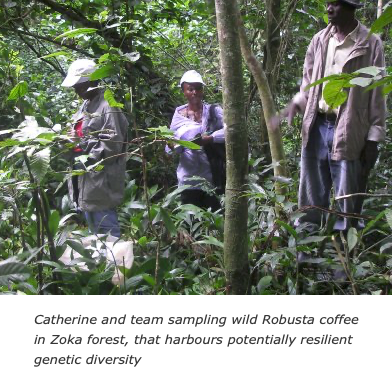Summary
Populations of potentially drought resistant wild Robusta coffee were identified in the PhD research of Catherine Kiwuka to be defended online on October 19. This study, in which CSA, the Ugandan National Agricultural Research Organisation (NARO), and the Institut de Reseserche pour le Développement (IRD) collaborated, raises hopes for developing drought resistant cultivars. But these populations occur in forests that are currently under threat of deforestation. For instance, the Zoka forest in Northern Uganda where the most valuable material occurs, is no more than a 10 km2 forest remnant and it’s under severe threat. Furthermore, the study shows that, while the wild populations in the north western part of the country are genetically unique, those in the south of the country are already genetically mixed with cultivated material...

Full text
Populations of potentially drought resistant wild Robusta coffee were identified in the PhD research of Catherine Kiwuka to be defended online on October 19. This study, in which CSA, the Ugandan National Agricultural Research Organisation (NARO), and the Institut de Reseserche pour le Développement (IRD) collaborated, raises hopes for developing drought resistant cultivars. But these populations occur in forests that are currently under threat of deforestation. For instance, the Zoka forest in Northern Uganda where the most valuable material occurs, is no more than a 10 km2 forest remnant and it’s under severe threat. Furthermore, the study shows that, while the wild populations in the north western part of the country are genetically unique, those in the south of the country are already genetically mixed with cultivated material.

Coffee is an important global commodity and its production sustains tens of millions mostly small-holder farmers across the tropics who are usually vulnerable to adverse effects of climate change. Coffee is also the main source of foreign income for Uganda. But estimates suggest that climate change through increased occurrence of droughts, heat waves and diseases may cause ~50% reduction in coffee production globally. Exploring genetic resources extant in wild coffee populations for climate and disease resilience is a means to address this issue. While Robusta coffee is generally of lower quality than arabica, it is also more climate resilient and the Ugandan Robusta is renowned for its arabica-like cup quality.
In short, this study highlights the importance of conserving and harnessing extant genetic resources in wild coffee populations, and it acutely points to the need to conserve and further investigate the material in Uganda.

